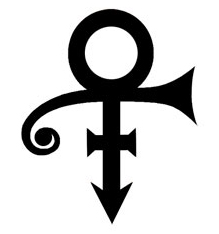As the founder and main creative engine of Paisley Park Enterprises, Prince was in the possession of approximately 10 registered trademarks still active and maintained at the time of death (the total exceeds 50 when including formerly used but now "dead" or inactive marks). While "PRINCE" and "NPG" (or New Power Generation) are well known monikers, the "symbol" may be the most well-known of Prince's many marks, which is an interesting juxtaposition given that he later adopted the symbol as his persona as a means to divorce the artist formerly known as "Prince" from the legal and business stranglehold of Warner Bros. records.
 One of the first uses of this icon was in the body shape of a Prince guitar. Later, this symbol was the subject of several trademark applications that matured into federally registered trademarks for a variety of goods and services. Those four registered marks continue in use.
One of the first uses of this icon was in the body shape of a Prince guitar. Later, this symbol was the subject of several trademark applications that matured into federally registered trademarks for a variety of goods and services. Those four registered marks continue in use.
Despite the extremely symbolic nature that this icon came to represent, a symbol that was used to publicly draw attention to the IP ownership and control issues faced by many recording artists, it is rather coincidental that a musician driven to haggle with his record company for a decade-plus over his creations was later pitted against his fans with the same control issues over his work. In the advent of the world wide web and the ability to electronically save and share data, at first it was the Napsters, Gnutellas, Kazaas, Aimsters, and the various peer-to-peer file-sharing platforms and then the multi-media platform of YouTube (and other lesser platforms) that surely gave the artist and his team headaches - a digital version of the carnival game "Whack-a-Mole".
Although many of the p-2-p platforms have diminished in popularity, YouTube is a different animal - and Prince was no shrinking violet when it came to the Digital Millennium Copyright Act's "take down notice" procedure. If popular press is to be believed, at the least, it seemed as though Prince was the main musical bully scouring YouTube for his content popping up in whatever video-based work, regardless of how imaginative or trans-formative. Before his death, scant-little Prince content was available on YouTube; as soon as someone was brave enough to post any back-catalog work, a DMCA take down notice quickly turned that video link into a snowy-video.
Even more noticeable and interesting in the days since his death - YouTube is now littered with Prince material. Whether those with monetary interests in the Prince catalog allow this unauthorized usage to continue unabated will be interesting to observe. It is rather ironic that the very platform that the artist resisted in using for sharing his back-catalog is now being used to shower the artist with admiration. However, it would hardly be surprising to learn that Prince envisioned this very thing.
Let's also hope that the man engaged in the appropriate forms of estate planning - and that those left with the responsibility of handling his estate for the foreseeable future prevent unauthorized exploitation of his name, image, and likeness. As so many estates of celebrities have learned, there is no shortage of free-riders willing to use the image of Elvis, Sinatra, and so many others to peddle sketchy merchandise.
RIP. Thank you for the music.